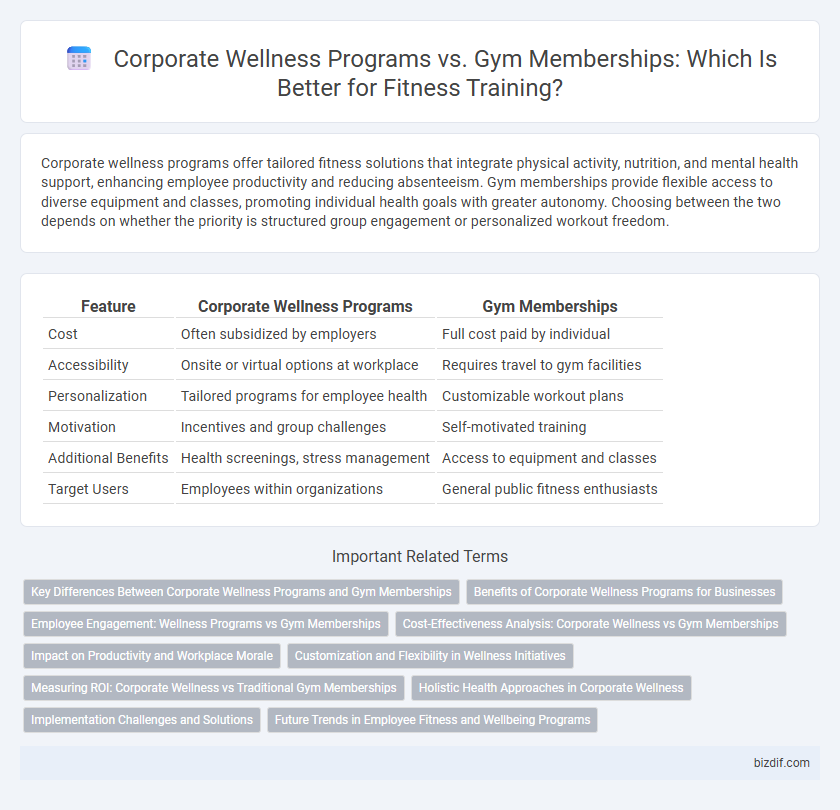Corporate wellness programs offer tailored fitness solutions that integrate physical activity, nutrition, and mental health support, enhancing employee productivity and reducing absenteeism. Gym memberships provide flexible access to diverse equipment and classes, promoting individual health goals with greater autonomy. Choosing between the two depends on whether the priority is structured group engagement or personalized workout freedom.
Table of Comparison
| Feature | Corporate Wellness Programs | Gym Memberships |
|---|---|---|
| Cost | Often subsidized by employers | Full cost paid by individual |
| Accessibility | Onsite or virtual options at workplace | Requires travel to gym facilities |
| Personalization | Tailored programs for employee health | Customizable workout plans |
| Motivation | Incentives and group challenges | Self-motivated training |
| Additional Benefits | Health screenings, stress management | Access to equipment and classes |
| Target Users | Employees within organizations | General public fitness enthusiasts |
Key Differences Between Corporate Wellness Programs and Gym Memberships
Corporate wellness programs offer tailored health initiatives and on-site fitness options designed to improve employee well-being and productivity, often integrating nutrition counseling and stress management. Gym memberships primarily provide access to exercise equipment, classes, and facilities without personalized workplace health strategies or incentives. Corporate wellness emphasizes holistic health benefits and organizational culture enhancement, while gym memberships focus on individual fitness goals and physical activity.
Benefits of Corporate Wellness Programs for Businesses
Corporate wellness programs boost employee productivity by promoting healthier lifestyles and reducing absenteeism through customized fitness and nutrition plans. Businesses benefit from lower healthcare costs and enhanced employee morale, leading to improved retention rates. Such programs foster a culture of wellness that helps attract top talent while supporting long-term organizational performance.
Employee Engagement: Wellness Programs vs Gym Memberships
Corporate wellness programs foster higher employee engagement by integrating fitness activities with health education, social support, and personalized goals, creating a comprehensive approach to well-being. Gym memberships often face lower participation rates due to lack of accessibility, convenience, and ongoing motivation outside the workplace. Structured wellness initiatives boost productivity and reduce absenteeism by embedding health into the company culture, surpassing the isolated benefits of gym memberships.
Cost-Effectiveness Analysis: Corporate Wellness vs Gym Memberships
Corporate wellness programs often provide a more cost-effective solution by offering tailored fitness initiatives, health screenings, and group activities that reduce overall healthcare expenses and improve employee productivity. Gym memberships typically involve individual expenses without the added benefits of integrated health monitoring or workplace convenience, potentially leading to underutilization and higher per capita costs. Studies indicate companies investing in wellness programs can achieve a return on investment (ROI) of $3 to $6 for every dollar spent, surpassing the general value of gym membership subsidies.
Impact on Productivity and Workplace Morale
Corporate wellness programs enhance productivity by integrating fitness activities tailored to employee needs, reducing absenteeism and boosting energy levels during work hours. Gym memberships offer personal health benefits but may lack the communal support and structured incentives that drive team motivation and workplace morale. Studies show companies with wellness initiatives report up to a 25% increase in employee engagement and a measurable improvement in overall organizational performance.
Customization and Flexibility in Wellness Initiatives
Corporate wellness programs offer highly customizable fitness training tailored to employee needs, promoting flexible schedules that accommodate varying work hours. Gym memberships provide standardized access to facilities but often lack personalized programming and adaptability to individual lifestyles. Emphasizing customization and flexibility, corporate wellness initiatives enhance engagement and improve overall health outcomes more effectively than generic gym plans.
Measuring ROI: Corporate Wellness vs Traditional Gym Memberships
Measuring ROI in corporate wellness programs involves evaluating reduced healthcare costs, increased employee productivity, and decreased absenteeism, often showing higher returns compared to traditional gym memberships. Corporate wellness initiatives provide tailored fitness plans and health education that foster long-term behavioral changes, unlike gym memberships that primarily offer access to facilities without engagement metrics. Data indicates companies investing in wellness programs observe up to 3:1 ROI through enhanced employee well-being and lower medical claims, surpassing the less quantifiable benefits of standard gym memberships.
Holistic Health Approaches in Corporate Wellness
Corporate wellness programs emphasize holistic health by integrating physical fitness, mental well-being, and nutritional support tailored to employee needs, promoting sustained engagement and productivity. Unlike traditional gym memberships that primarily focus on physical exercise, corporate wellness initiatives offer comprehensive health assessments, stress management workshops, and personalized coaching. These multifaceted approaches contribute to reduced absenteeism, enhanced job satisfaction, and long-term organizational health benefits.
Implementation Challenges and Solutions
Corporate wellness programs face implementation challenges such as varying employee engagement levels, diverse fitness needs, and integration into work schedules, which require tailored, flexible solutions like personalized fitness plans and on-site classes. Gym memberships often encounter barriers including limited access during work hours and low motivation, addressed through partnerships providing off-peak access and incentivized attendance. Both approaches benefit from leveraging technology for tracking progress and fostering community support to enhance adherence and outcomes.
Future Trends in Employee Fitness and Wellbeing Programs
Corporate wellness programs are increasingly integrating AI-driven personalized fitness plans and virtual reality workouts to enhance employee engagement and health outcomes. Gym memberships are evolving to offer hybrid models combining digital platforms with in-person training to accommodate flexible work schedules. Future trends emphasize holistic wellbeing approaches, incorporating mental health support and biometric monitoring to optimize employee productivity and reduce healthcare costs.
Corporate wellness programs vs Gym memberships Infographic

 bizdif.com
bizdif.com